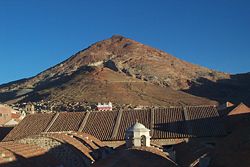
Miner
Diego Gualpa
16th C
The Spanish conquest of South America led to the discovery of Peruvian mountains rich in gold and silver. In April, 1545, high up in the Andes, an Indian named Diego Gualapa climbed a distinctively shaped conical peak in search of a rumoured Indian shrine. Such shrines frequently contained some gold or silver relics suitable for plunder. The peak was located at an altitude of 4,824 metres (15,287 ft.) above sea level. Windswept and cold, it was surrounded by a barren, treeless expanse where not even enough grass grew to feed cattle. The story goes that Gualapa was thrown to the ground by a high wind. After scrabbling for a handhold, when he felt secure enough to observe his surrounds, he found that he was gripping rich silver ore. He reported the find to Spanish mine owners in nearby Porco eventually persuading Diego de Villaroel to accompany him back to the site. Villaroel's inspection confirmed an abundance of silver laying very close to the surface. This was the discovery of the silver mountain of Potosi.
The mountain was renamed Cerro Rico. Cerro Rico is the reason for Potosí's historical importance, since it was the major supply of silver for Spain during the period of the New World Spanish Empire. Beginning in 1545 it soon produced fabulous wealth, and the population eventually exceeded 200,000 people. The city gave rise to a Spanish expression, still in use: vale un Potosí, ("to be worth a Potosí") meaning "to be of great value". Cerro Rico, produced an estimated 60% of all silver mined in the world during the second half of the 16th century. The silver was taken by llama and mule train to the Pacific coast, shipped north to Panama City, and carried by mule train across the isthmus of Panama to Nombre de Dios or Portobelo, whence it was taken to Spain on the Spanish treasure fleets. Some of the silver also made its way east to Buenos Aires, via the Rio de la Plata. Charles V was moved to grant the sprawling settlement the title of Imperial 'city, with a Coat of Arms bearing the legend "I am rich Potosí, treasure of the world, trekking of all mountains and the envy of all kings."
Potosi has a long and storied history of labour problems. From around 1600, the death rate skyrocketed among the local Indian communities. An estimated 30,000 African slaves were taken to Potosi during the colonial ere. They too were also forced to work in the Casa de la Moneda (mint) as mulas humanas (human mules). Since mules would die after a couple of months pushing the mills, the colonists replaced the four mules with twenty African slaves.
Today the city is a UNESCO World Heritage site.
Last Updated on: 2024-02-28
